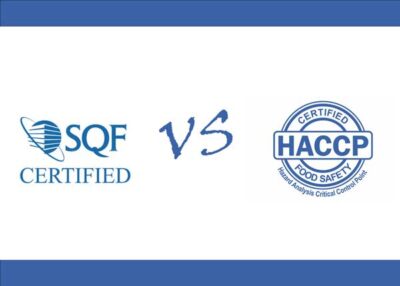
Navigating the differences between the two and how each fit into food safety compliance can be difficult, so we thought we’d share some takeaways to help shed some light on this subject.
HACCP
The Hazard Analysis and Critical Control Points (HACCP) was created to identify and limit food safety risks by requiring process documentation that adheres to internationally recognized standards. Where companies in the US tend to use NSF guidelines to recognize food safe products, many countries outside the US rely on HACCP to address food safety by analyzing biological, chemical and physical hazards from raw material production, procurement and handling, to manufacturing, distribution and consumption of the finished product.
SQF Certification
Similar in many ways to HACCP, the Safe Quality Food Institute’s (SQF) certification is a food safety management system which is also accepted as an international standard of excellence. The SQF requires food producers and manufacturers to prove they have vigorous food safety control systems in place and verifies those claims by sending third-party auditors to inspect facilities. The certification illustrates a company’s commitment to safety and assures confidence for their customers by demonstrating that their food has been properly produced, handled, packaged, stored and transported safely.
In short, the SQFI provides education and a single certification for food manufacturers, distributors and brokers to showcase adherence to the highest standards of food safety from farm to fork.
SQF vs HACCP
The difference between an SQF Certification and the HACCP program can be confusing, primarily because they intersect in several places.
In many ways, the SQF certification picks up where the HACCP ends. Think of SQF as an interpretation of HACCP guidelines from a procedural standpoint. Organizations that are compliant with HACCP still need to design, document and implement the SQF food safety management system process before becoming SQF certified.
Due to its stricter requirements, SQF certification is less commonly sought out by food manufacturers and producers, but shows a commitment to food safety that goes above and beyond HACCP standards. On the other hand, HACCP food-safe equipment, materials and services are implemented across America, Europe, Asia and Australasia making it one of the largest food safety standards on the planet.
How Bradley Can Help
If your company is interested in pursuing HACCP or SQF certification, you’ll eventually need to take a look at the cleaning products you’re using. Are they helping you comply with these safety requirements?
If not, and you suspect Bradley might be able to help, we’d be happy to talk. We specialize in safe cleaning solutions that work, and our products RTX-9 Turbo Food Grade and Yellow Magic 7 were designed for food safety. RTX-9 Turbo Food Grade was formulated to be completely safe for cleaning food storage areas and food transportation fleets, and Yellow Magic 7 was created specifically as a flexo UV ink and varnish cleaner for printing human and pet food packaging. Both products are NSF registered and both are consistent with SQF and HACCP standards.
To learn more about how our products might help with your food safety compliance goals, feel free to get in touch. If our products aren’t a good fit for whatever reason, we’ll do our best to point you in the right direction.





